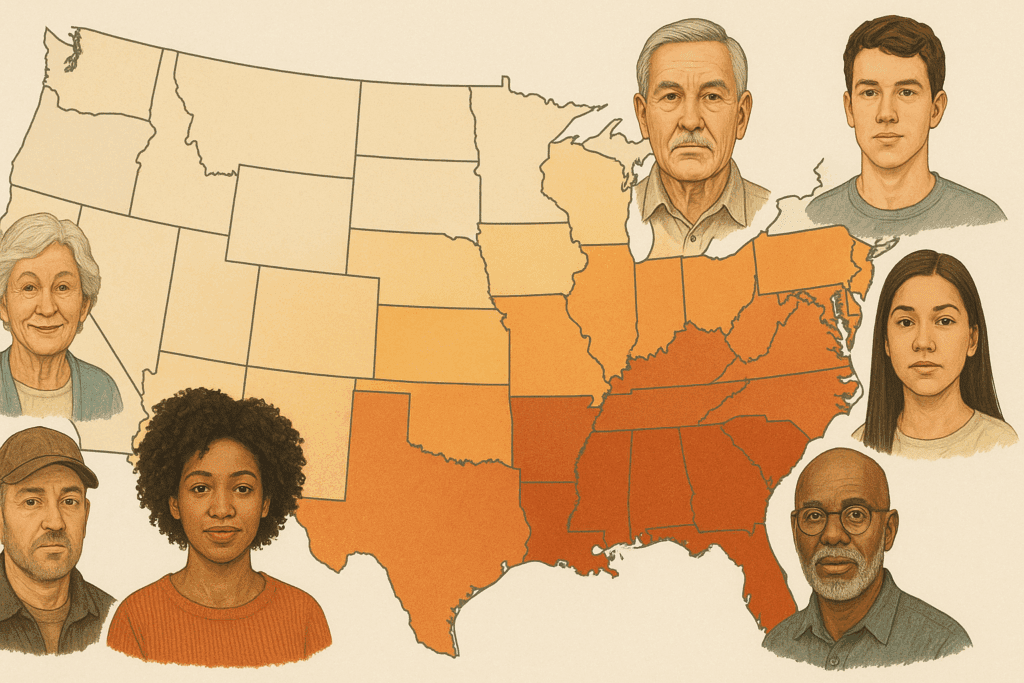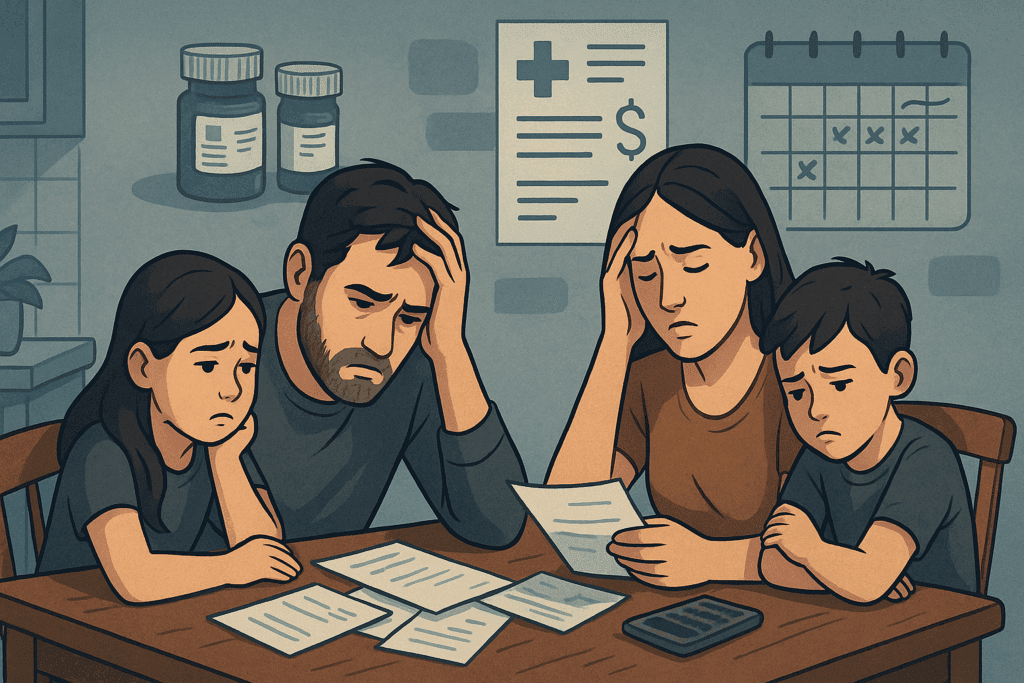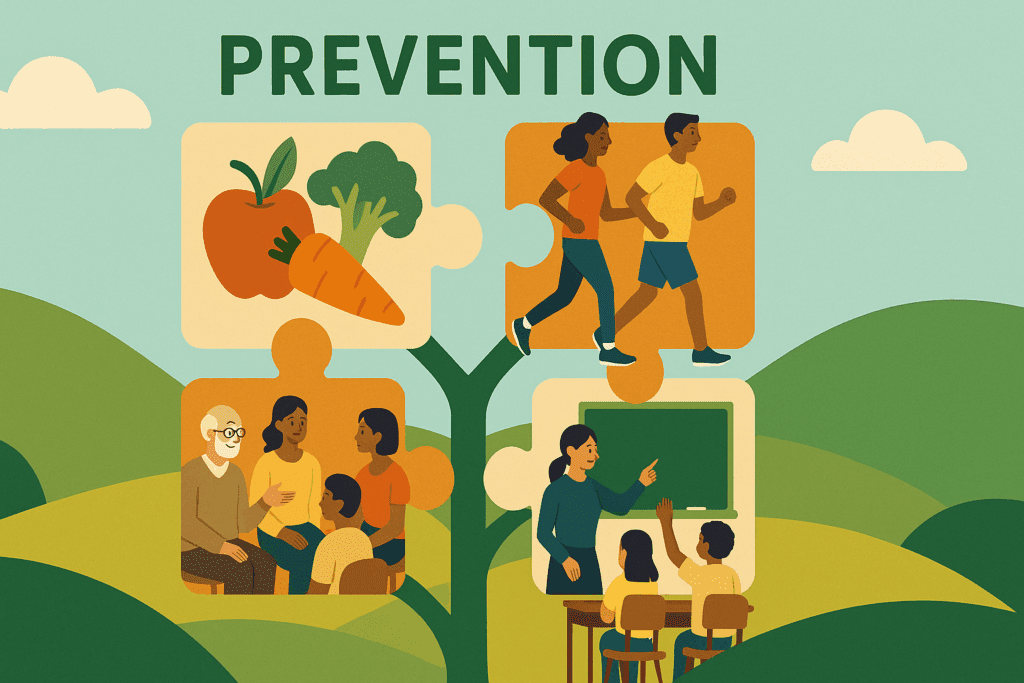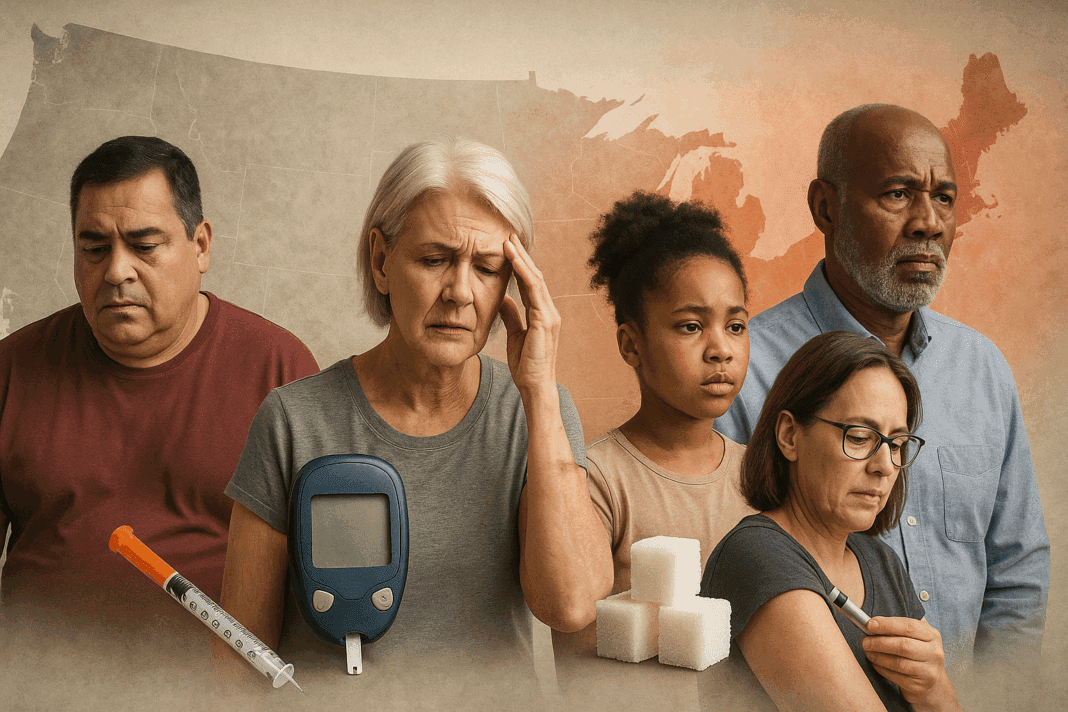Understanding the Scope of Diabetes in America
Diabetes has become one of the most pressing chronic health conditions in the United States, impacting millions and exerting a heavy toll on the nation’s public health and economy. Recent data from the Centers for Disease Control and Prevention (CDC) has shed new light on just how widespread this condition truly is. These updated figures provide not only insight into the current number of diabetics in the US but also a sobering view of how diabetes in America has evolved over the years. For health professionals, policymakers, and everyday citizens alike, understanding the national diabetes rate USA-wide is essential to grasping the broader implications for public health, health care costs, and quality of life.
You may also like: Breakthroughs in Current Diabetes Research: What the Latest Studies Reveal About Treatment and Prevention
With millions of Americans now living with either type 1 or type 2 diabetes, the scope of the issue continues to expand, fueled by a combination of genetic, behavioral, and environmental factors. The urgency of the situation is reflected in the CDC’s latest surveillance reports, which highlight concerning trends in both incidence and prevalence. As we explore how many people in the United States have diabetes and how many Americans are diabetic today, it becomes increasingly clear that robust public health responses, education initiatives, and community-based interventions are vital for reversing this growing epidemic.

Tracking the Numbers: How Many People Have Diabetes in the US?
According to the most recent CDC data, over 38 million people in the United States are living with diabetes. This figure includes both diagnosed and undiagnosed cases, as well as individuals with type 1 and type 2 diabetes. This means that approximately 11.6% of the total U.S. population is affected by the condition. The percentage of Americans with diabetes has risen significantly over the past few decades, reflecting both improved diagnostic efforts and an underlying increase in risk factors such as obesity, sedentary lifestyles, and poor dietary habits.
When exploring how many people suffer from diabetes in the US, it’s important to consider both the known and hidden burden of the disease. Roughly one in five adults with diabetes is unaware that they even have the condition. This underdiagnosis adds to the complexity of managing the national diabetes rate USA-wide, as undetected cases can lead to complications before treatment begins. As the number of diabetics in the US continues to climb, early detection and prevention strategies become all the more crucial.

Type 1 vs. Type 2 Diabetes: Understanding the Breakdown
The question of how many Americans have type 1 diabetes versus type 2 diabetes offers further insight into the complexity of this condition. Type 1 diabetes, an autoimmune disorder typically diagnosed in childhood or adolescence, affects approximately 1.9 million Americans. The type 1 diabetes prevalence has remained relatively stable over time, but recent data suggest a slight uptick in cases, potentially due to better awareness and diagnostic practices.
In contrast, type 2 diabetes, which is often associated with lifestyle factors and typically manifests later in life, is responsible for the vast majority of cases. Over 90% of diabetics in the U.S. fall into this category. Understanding how many Americans have type 2 diabetes is critical for shaping public health strategies, particularly those targeting nutrition, physical activity, and obesity prevention. The growing number of adults and even adolescents diagnosed with type 2 highlights a broader shift in how the disease presents across different age groups and demographics.

Historical Trends and the Rising Prevalence of Diabetes in the United States
Looking at the rates of diabetes over the years reveals a dramatic escalation. In 1980, only about 5.5 million Americans were diagnosed with diabetes. Fast forward to today, and the number of diabetics in the US has increased nearly sevenfold. This exponential growth underscores a major shift in the health landscape, with the prevalence of diabetes in America rising in tandem with other chronic conditions such as obesity and hypertension.
Several factors have contributed to this trend, including changes in dietary patterns, urbanization, increased consumption of processed foods, and a decline in physical activity. As a result, the prevalence of diabetes in the United States has become a major public health concern. While improved screening and medical diagnostics have certainly played a role in detecting more cases, the underlying surge in new diagnoses reflects a growing disease burden that cannot be ignored.

Who Is Most Affected? Demographic and Geographic Variations
The prevalence of diabetes in the US does not affect all populations equally. Certain racial and ethnic groups, including African Americans, Hispanic/Latino Americans, Native Americans, and Asian Americans, exhibit higher diabetes rates compared to non-Hispanic whites. Socioeconomic status, education level, and geographic location also influence the percentage of diabetes in the US. For example, southern states with higher rates of obesity and poverty often report greater concentrations of diabetics.
Understanding how many diabetics are there in the US also involves breaking down the data by gender, age, and income level. Older adults aged 65 and above represent the highest proportion of individuals diagnosed with diabetes, while younger adults and adolescents are increasingly being affected, particularly by type 2 diabetes. Recognizing these patterns can help tailor public health initiatives to target high-risk populations more effectively.

Unpacking the Economic Burden of Diabetes in America
The human toll of diabetes is immense, but the economic consequences are equally staggering. The latest estimates suggest that the total annual cost of diagnosed diabetes in the U.S. exceeds $327 billion, factoring in direct medical costs and lost productivity. This economic strain impacts not only the individuals living with diabetes but also their families, employers, and the broader healthcare system.
Given how many Americans suffer from diabetes, these costs are expected to rise unless more effective prevention and management strategies are put in place. Hospitalizations, medication expenses, and long-term care for complications such as kidney disease, neuropathy, and cardiovascular issues contribute significantly to these costs. Understanding the true scope of diabetes in the United States allows for better resource allocation and policy planning to reduce this financial burden.
Diabetes Death Rates and Complications: A Continuing Concern
Despite advancements in treatment, diabetes death rates remain a major concern. Complications arising from poorly controlled blood glucose levels can lead to serious, life-threatening conditions including stroke, heart attack, kidney failure, and limb amputations. In fact, diabetes remains one of the leading causes of death in the country. The risk of premature mortality is substantially higher among people with diabetes compared to those without the disease.
Analyzing current diabetes numbers shows that better management of the disease—through medication, lifestyle changes, and access to care—can significantly reduce the risk of these outcomes. However, disparities in access to healthcare, particularly in underserved communities, mean that many people continue to face barriers to effective management. Addressing diabetes in America requires not only medical treatment but also systemic changes that ensure equitable access to care.

Preventing the Rise: Strategies for Reducing the Prevalence of Diabetes in the United States
Public health efforts aimed at lowering the prevalence of diabetes in the US are multifaceted and require collaboration across sectors. Programs such as the National Diabetes Prevention Program (NDPP), which targets individuals at high risk of developing type 2 diabetes, have demonstrated success in reducing the incidence of the disease through lifestyle interventions. Encouraging healthy eating, physical activity, and weight management are core components of these initiatives.
Understanding what percentage of Americans have diabetes and identifying the highest-risk groups enables health officials to direct resources where they are most needed. Community-based programs, school nutrition initiatives, and workplace wellness policies can all play a role in reducing risk factors. Moreover, investments in education campaigns that raise awareness about the early signs and symptoms of diabetes can lead to earlier diagnosis and better outcomes.
Looking Ahead: Future Projections and Challenges
If current trends continue, the number of people with diabetes in the United States is projected to increase dramatically in the coming decades. Some forecasts estimate that by 2050, nearly one in three American adults could be diabetic. This anticipated rise will further strain healthcare resources and increase the national diabetes rate USA-wide.
Ongoing research into diabetes prevention and treatment, including new medications, continuous glucose monitoring technologies, and potential cures such as beta-cell regeneration and immunotherapy, may help change the course of the disease. However, the success of these innovations depends heavily on widespread access and affordability. As the conversation about how many Americans have diabetes continues, it must be accompanied by strategic planning and investment in both science and public health infrastructure.
Frequently Asked Questions (FAQ): Diabetes in the United States
1. Why has the prevalence of diabetes in the United States continued to rise even with more public awareness?
While public awareness has certainly improved, the rise in the prevalence of diabetes in the United States stems from a confluence of modern-day lifestyle factors and socioeconomic disparities. Sedentary behavior, processed food consumption, and urban living all contribute to increased risk, particularly for type 2 diabetes. Despite advances in education, high-calorie diets and limited access to affordable, healthy food in underserved communities exacerbate the problem. Furthermore, the national diabetes rate USA-wide reflects challenges in healthcare accessibility, especially for routine screening. As such, even though people may know about diabetes, systemic barriers often prevent timely diagnosis and effective intervention, adding to the growing number of diabetics in the US.
2. What social factors contribute to diabetes disparities across racial and economic lines?
The uneven burden of diabetes in America highlights long-standing social inequities. Minority populations—particularly African American, Native American, and Hispanic communities—tend to face higher rates of diabetes over the years due to factors like food deserts, healthcare bias, and historical disenfranchisement. Poverty often limits access to preventive services and medications, directly influencing how many Americans suffer from diabetes and how many people in the US are diabetic without knowing it. Lower educational attainment can also reduce health literacy, making it harder for individuals to manage or even recognize early symptoms. Consequently, when evaluating how many people in the United States have diabetes, the statistics reflect not just biological trends, but deep-rooted societal imbalances.
3. How does mental health impact diabetes outcomes and long-term management?
Mental health plays a crucial but often overlooked role in diabetes outcomes. Depression and anxiety are common comorbidities among those diagnosed with diabetes in the United States, and they can significantly affect medication adherence, dietary choices, and motivation for physical activity. Research suggests that poor mental health may even increase physiological stress, worsening blood glucose control. When exploring the percentage of Americans with diabetes who experience complications, a notable proportion also report psychological distress. Considering the rising diabetes numbers, integrative care that addresses emotional well-being alongside physical health could be a key strategy for improving the quality of life and reducing diabetes death rates.
4. Are youth and adolescents increasingly affected by type 2 diabetes?
Yes, youth-onset type 2 diabetes is a growing concern in the U.S. While type 1 diabetes prevalence has historically been higher among children, there’s a troubling trend of type 2 diagnoses in younger populations, particularly among teens from high-risk ethnic groups. This shift alters the conversation around how many people have diabetes in the US, as earlier onset often leads to earlier complications and prolonged disease burden. The rising number of diabetics in the US under age 20 also signals the need for earlier intervention and lifestyle education in schools. Public health experts warn that without major change, the national diabetes rate USA may soon reflect worsening outcomes for younger generations.
5. What technological advancements are shaping the future of diabetes management?
Recent innovations are revolutionizing diabetes care, making it easier for patients to monitor and manage their condition. Continuous glucose monitors (CGMs), smart insulin pens, and closed-loop systems are giving individuals more control and real-time insights. These technologies have become especially helpful in managing type 1 diabetes prevalence among both children and adults. As diabetes in the United States becomes more common, technology can play a pivotal role in personalizing treatment and reducing long-term complications. Additionally, predictive analytics powered by artificial intelligence are being explored to help identify individuals at risk, potentially decreasing how many Americans have type 2 diabetes in the future.
6. How is the healthcare system responding to the increasing number of people with diabetes?
Healthcare systems are gradually shifting from reactive care to prevention-focused models. Initiatives like the CDC’s National Diabetes Prevention Program (NDPP) have shown promise in reducing the percentage of diabetes in the US by targeting those with prediabetes through lifestyle intervention. However, with such a high number of diabetics in the US, scalability and sustainability of these programs remain major challenges. Additionally, many insurers are beginning to cover preventive services and telehealth appointments, which may help reach more people who otherwise fall through the cracks. Understanding how many people have diabetes in the US underscores the need for healthcare reform that centers on accessibility, equity, and long-term outcomes.
7. What are the long-term societal costs of unchecked diabetes growth in America?
The long-term societal costs of increasing diabetes prevalence in America extend far beyond direct medical expenses. Lost productivity, increased disability claims, and workforce attrition contribute to a weakened economy and strained public resources. As the United States diabetes rate continues to rise, the need for long-term care, dialysis, and amputations becomes more frequent and expensive. These consequences add pressure to social security, Medicare, and family caregiving systems. When asking how many Americans are diabetic, it’s not just a medical inquiry but a signal of how chronic diseases are reshaping the American economic and social landscape.
8. What role does early detection play in reducing diabetes-related complications?
Early detection is one of the most powerful tools in mitigating diabetes complications. Diagnosing diabetes early can delay or prevent damage to the heart, kidneys, eyes, and nerves—common complications that contribute to rising diabetes death rates. Because a significant number of Americans are undiagnosed, the question of how many people have diabetes in the US may actually underestimate the true burden. Screening campaigns, especially in underserved areas, could reveal a larger number of diabetics in the US than current statistics suggest. Investing in regular A1C testing and outreach can shift the curve of the prevalence of diabetes in the United States toward more favorable outcomes.
9. How are communities adapting to the rise in diabetes cases?
Local communities across the U.S. are launching grassroots programs to tackle diabetes from the ground up. From community gardens that address food insecurity to culturally tailored education sessions, these initiatives aim to reduce the prevalence of diabetes in America through empowerment and engagement. Faith-based organizations, tribal health programs, and local nonprofits are increasingly involved in efforts to reduce how many people in America have diabetes through personalized outreach. Such community-driven interventions complement national strategies and help address gaps that larger systems may overlook. Understanding how many Americans have type 1 diabetes or type 2 diabetes on a regional level allows for more effective, localized responses.
10. What future developments could significantly change the diabetes landscape in the US?
The future of diabetes care is being shaped by promising research into beta-cell regeneration, immunotherapy for type 1 diabetes, and genetic screening for early risk identification. These emerging treatments could reduce how many people suffer from diabetes in the US by halting or even reversing disease progression. At the same time, nationwide policy shifts—such as food subsidies for healthier items or taxes on sugary beverages—could influence population-level behaviors that affect the national diabetes rate USA. Understanding what percent of Americans have diabetes today provides a benchmark, but future interventions could dramatically shift the curve. With focused investment in research, public health, and technology, we may one day see a reversal in the percentage of diabetes in the US, offering hope for millions now living with the condition.
Conclusion: Why Accurate Diabetes Data Matters More Than Ever
The latest CDC findings highlight the importance of regularly updating and disseminating accurate information about how many people in the US are diabetic. As we uncover the true scope of diabetes in the United States, it becomes clear that this is not merely a personal health issue but a societal challenge with far-reaching implications. Knowing the number of diabetics in the US and understanding demographic and geographic variations empowers public health officials, researchers, and community leaders to develop targeted strategies.
Understanding the percentage of Americans with diabetes and tracking the rates of diabetes over the years provides context for how this epidemic has unfolded. When we ask questions like “how many people have diabetes in the US?” or “what percent of Americans have diabetes today?” we are doing more than citing statistics; we are identifying the areas where action is needed most. From diabetes death rates to the economic cost and the promise of prevention, this growing crisis requires sustained attention and informed decision-making.
Ultimately, reversing the prevalence of diabetes in America will require more than medical innovation alone. It demands a comprehensive approach that integrates clinical care, policy reform, public education, and community support. With over 38 million people affected and more on the horizon, the question is no longer just how many Americans are diabetic—it’s what are we going to do about it?
Further Reading:
Economic Costs of Diabetes in the U.S. in 2022
Diabetes Statistics in the United States
Disclaimer
The information contained in this article is provided for general informational purposes only and is not intended to serve as medical, legal, or professional advice. While MedNewsPedia strives to present accurate, up-to-date, and reliable content, no warranty or guarantee, expressed or implied, is made regarding the completeness, accuracy, or adequacy of the information provided. Readers are strongly advised to seek the guidance of a qualified healthcare provider or other relevant professionals before acting on any information contained in this article. MedNewsPedia, its authors, editors, and contributors expressly disclaim any liability for any damages, losses, or consequences arising directly or indirectly from the use, interpretation, or reliance on any information presented herein. The views and opinions expressed in this article are those of the author(s) and do not necessarily reflect the official policies or positions of MedNewsPedia.


